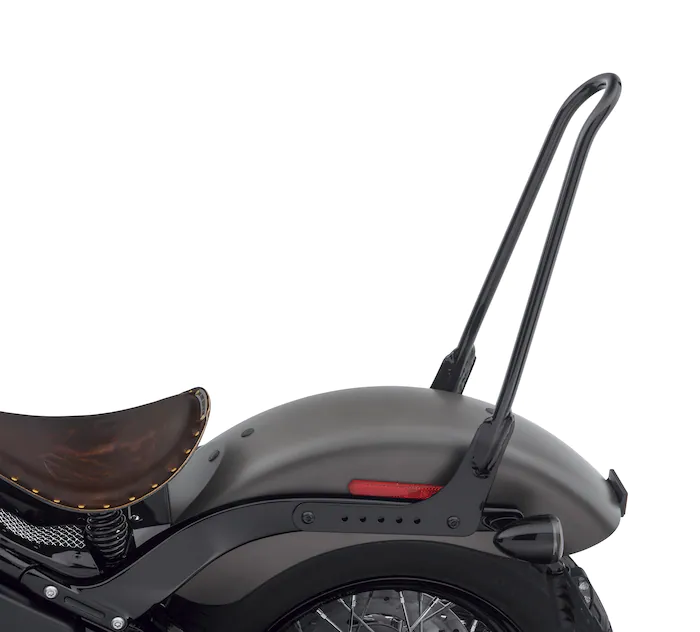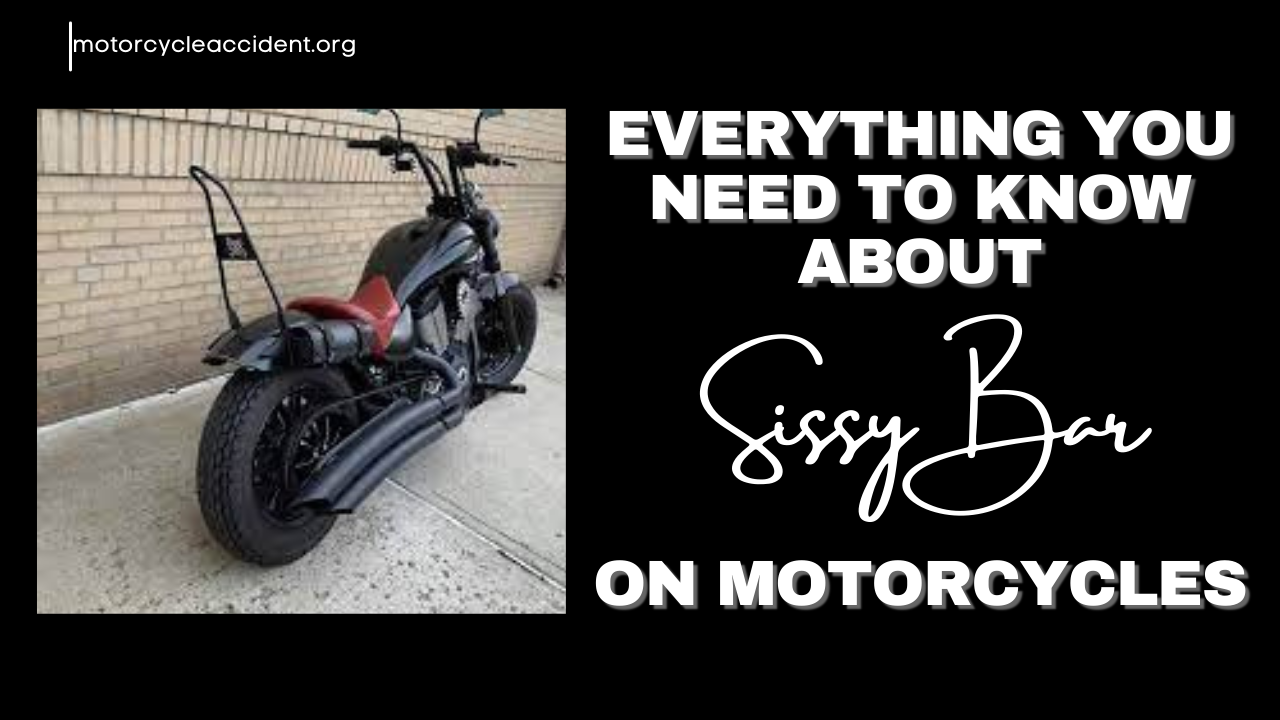A sissy bar is a motorcycle accessory that provides additional support and comfort for the passenger. They are often made of steel or aluminum and can be fixed or adjustable. If you are thinking about adding a sissy bar to your motorcycle, there are a few things you need to know first. This blog post will discuss the different types of sissy bars available and their benefits and drawbacks. We will also provide tips on choosing the right one for your bike.
What is a sissy bar
A sissy bar is a support bar attached to the back of a motorcycle seat. The primary purpose of a sissy bar is to provide passengers with a place to grip when riding on the back of a motorcycle. You can also attach luggage or other gear to the bike. Sissy bars come in various sizes and styles, so riders can choose one that best suits their needs. Some sissy bars are removable, so they can be taken off when not used. Others are permanently attached to the bike. Sissy bars can be a great addition to any motorcycle, and they can provide both riders and passengers with an extra sense of security when on the road.
What are the different types of sissy bars?
There are a few different sissy bars, each with advantages and disadvantages. The first type is the essential straight sissy bar, the simplest and most common type. These bars are typically made of metal or plastic, and they attach to the back of the bike. They provide a good amount of support and stability, but they can be uncomfortable for long rides. The second type is the contoured sissy bar, which is designed to follow the curve of your back for added comfort. These bars are usually made of padded leather or fabric, which can be pretty expensive. However, they’re definitely worth the investment if you plan on doing a lot of riding. The last type is the adjustable sissy bar, which allows you to change the height and angle of the bar to suit your needs. These bars are very versatile, but they can be a bit pricier than the others. Whichever type you choose, make sure that it’s compatible with your bike and suits your riding style.

How do you install a sissy bar?
A sissy bar is a great way to add extra style to your motorcycle. They’re also great for giving your passenger something to hold on to, and they can provide some additional support if you need to strap down some gear. Installing a sissy bar is relatively simple, but it’s essential to make sure that it’s installed correctly to provide the support you need.
First, you’ll need to gather the correct hardware. Most sissy bars will come with everything you need, but it’s always good to double-check before starting. Once you have everything you need, the first step is to mount the sissy bar brackets to the rear fender. Make sure that the brackets are mounted securely to avoid coming loose while you’re riding.
Next, attach the sissy bar itself to the brackets. Again, make sure that everything is tight and secure before taking your motorcycle out for a spin. With the sissy bar installed, you can now add additional accessories, such as a luggage rack or backrest pad. Just make sure that they’re also secure.
What are the benefits of using a sissy bar?
If you ride a motorcycle, you’ve seen a sissy bar before. But what exactly is it, and what are the benefits of using one? A sissy bar is simple vertical support that attaches to the back of a motorcycle seat. It’s usually made of metal or plastic, and it can be either removable or permanent. The primary purpose of a sissy bar is to provide passengers with a backrest, making it more comfortable for them to sit on the back of the bike. In addition, sissy bars can also offer some protection in a rear-end collision. By absorbing some of the force from the impact, sissy bars can help to protect both riders and passengers from serious injuries. As you can see, there are many good reasons to invest in a sissy bar for your motorcycle. Whether you’re looking for better passenger comfort or enhanced safety, a sissy bar can be a great addition to your bike.
How to choose the right sissy bar for your motorcycle
If you’re looking to add a sissy bar to your motorcycle, there are a few things you’ll need to take into consideration. First, think about the style of your bike. For example, a sleek and minimalist sissy bar will look out of place on a chopper. Second, consider the material. Most sissy bars are made from either steel or aluminum, but you may also find some made from other materials like carbon fiber. Third, think about how much weight you’ll be carrying on the back of your bike. If you’re planning on having a lot of gear, you’ll need a sissy bar to support the weight. Finally, take into account the overall dimensions of your bike. You don’t want a sissy bar that’s so big it blocks your rearview! With these things in mind, you should be able to find the perfect sissy bar for your motorcycle.
FAQs about Motorcycle Sissy Bar
A motorcycle sissy bar is a vertically mounted bar located behind the motorcycle seat. Its purpose is to provide passengers with a grab handle to hold onto while riding and increase the stability of bikes when they are stationary. Sissy bars come in various sizes and styles and can be easily installed on most motorcycles. Here are some Frequently Asked Questions about motorcycle sissy bars:
Where to buy a motorcycle sissy bar, and how much does it cost?
A motorcycle sissy bar is a convenient way to carry extra cargo on your bike, and they’re relatively inexpensive, too. You can find them at most motorcycle dealerships or online retailers. They typically range in price from $30-$100, depending on the size and style of the sissy bar. When choosing a sissy bar, be sure to select one compatible with your bike’s make and model. Once you have your sissy bar, installing it is relatively straightforward. Most sissy bars come with all the necessary hardware and instructions. If you have any questions, consult your bike’s owner’s manual or ask a qualified mechanic for help. With a bit of effort, you can enjoy the convenience of a motorcycle sissy bar without breaking the bank.
When to replace a sissy bar for your motorcycle
Sissy bars are a great way to add extra back support to your motorcycle ride. But like anything else on your bike, they eventually wear out and need to be replaced. So how do you know when it’s time for a new sissy bar? There are a few things to look for. First, check the welds to make sure they’re still strong. If they’re starting to crack or break, it’s time for a new bar. Also, take a look at the padding. If it’s torn or faded, it’s probably not doing much to support your back anymore. Finally, pay attention to how the sissy bar is mounted to the bike. If it’s loose or wobbling, it needs to be tightened or replaced. By keeping an eye on these things, you can make sure your sissy bar is always up to keep you comfortable on your motorcycle ride.

What is the material of the sissy bar?
The sissy bar is usually steel, aluminum, or composite materials. The most common type of sissy bar is the steel sissy bar. Steel is solid and durable, making it ideal for motorcycles. Steel sissy bars are usually powder-coated to improve their appearance and prevent rusting. Aluminum sissy bars are also popular because they are lightweight and easy to install. However, aluminum sissy bars can bend more easily than steel sissy bars, so they may not be suitable for heavy-duty applications. Composite sissy bars are made from various materials, including carbon fiber and Kevlar. These materials are solid and difficult to break, making them ideal for use on racing motorcycles.
What is the weight capacity of the sissy bar?
The sissy bar on a motorcycle is designed to provide extra support for the rider. It is typically used when carrying a passenger, but it can also be helpful when carrying extra gear. The weight capacity of the sissy bar will vary depending on the make and model of the motorcycle. However, most sissy bars can support up to 250 pounds. When loading extra weight onto the sissy bar, it is important to evenly distribute the weight to avoid putting too much strain on one side of the motorcycle. Additionally, it is essential to ensure that all straps and bungee cords are securely fastened to prevent items from falling off during transit.
What is the height of the sissy bar?
The sissy bar is support attached to the back of a motorcycle seat. Its purpose is to provide passenger comfort and safety. Sissy bars come in various heights, depending on the make and model of the motorcycle. Typically, they range from about 12 inches to 24 inches. The height of the sissy bar can also be adjustable so that riders can customize it to their needs. Revers who frequently carry passengers may want a taller sissy bar, while those who occasionally have a passenger may prefer a shorter one. Ultimately, the best height for a sissy bar provides comfort and safety for the rider and passenger.
What is the width of the sissy bar?
The sissy bar on a motorcycle is a metal or plastic bar attached to the back of the seat. It is used to provide passenger support and stability. The width of the sissy bar varies depending on the make and model of the motorcycle, but it is typically between 12 and 16 inches wide. Some sissy bars also have a pad that you can use for additional comfort. Sissy bars are an essential safety feature, especially for riders who frequently travel with passengers. They help prevent passengers from falling off the back of the bike, and they also provide a stable platform for passengers to rest their feet. When choosing a sissy bar, it is essential to select one that is the right size and shape for your motorcycle. You should also make sure that it is compatible with any other accessories you might want to add, such as luggage racks or storage bags.
Conclusion
So, there you have it – everything you need to know about sissy bars on motorcycles. Whether you’re in the market for a new one or are just curious about what they are and do, we hope this article has been helpful. If you have any questions, feel free to reach out to us. We love talking about all things motorcycle! And that’s it for today! Thanks for reading, and check back soon for more great content.





